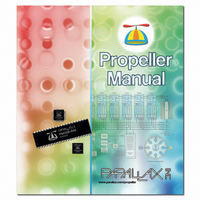122-32000 Parallax Inc, 122-32000 Datasheet - Page 22

122-32000
Manufacturer Part Number
122-32000
Description
MANUAL PROPELLER
Manufacturer
Parallax Inc
Specifications of 122-32000
Accessory Type
Manual
Lead Free Status / RoHS Status
Lead free / RoHS Compliant
For Use With/related Products
Propeller Education (PE) Kit
Lead Free Status / Rohs Status
Lead free / RoHS Compliant
- Current page: 22 of 438
- Download datasheet (5Mb)
Introducing the Propeller Chip
Shared Resources
There are two types of shared resources in the Propeller: 1) common, and 2) mutually-
exclusive.
Common resources can be accessed at any time by any number of cogs.
Mutually-exclusive resources can also be accessed by any number of cogs, but only by one
cog at a time. The common resources are the I/O pins and the System Counter. All other
shared resources are mutually-exclusive by nature and access to them is controlled by the
Hub. See the Hub section on page 24.
System Clock
The System Clock (shown as “CLOCK” in Figure 1-2) is the central clock source for nearly
every component of the Propeller chip. The System Clock’s signal comes from one of three
possible sources: 1) the Internal RC Oscillator, 2) the Clock Phase-Locked Loop (PLL), or
3) the Crystal Oscillator (an internal circuit that is fed by an external crystal or
crystal/oscillator pack). The source is determined by the CLK register’s settings, which is
selectable at compile time or at run time. The only components that don’t use the System
Clock directly are the Hub and Bus; they divide the System Clock by two (2).
Cogs (processors)
The Propeller contains eight (8) processors, called cogs, numbered 0 to 7. Each cog contains
the same components (see Figure 1-2): a Processor block, local 2 KB RAM configured as 512
longs (512 x 32 bits), two I/O Assistants with PLLs, a Video Generator, I/O Output Register,
I/O Direction Register, and other registers not shown in the diagram. See Table 1-3 for a
complete list of cog registers. Each cog is designed exactly the same and can run tasks
independently from the others.
All eight cogs are driven from the same clock source, the System Clock, so they each
maintain the same time reference and all active cogs execute instructions simultaneously.
See System Clock, above. They also all have access to the same shared resources, like I/O
pins, Main RAM, and the System Counter. See Shared Resources, above.
Cogs can be started and stopped at run time and can be programmed to perform tasks
simultaneously, either independently or with coordination from other cogs through Main
RAM. Regardless of the nature of their use, the Propeller application designer has full
control over how and when each cog is employed; there is no compiler-driven or operating
system-driven splitting of tasks between multiple cogs. This method empowers the developer
to deliver absolutely deterministic timing, power consumption, and response to the embedded
application.
Page 22 · Propeller Manual v1.0
Related parts for 122-32000
Image
Part Number
Description
Manufacturer
Datasheet
Request
R

Part Number:
Description:
MANUAL FOR SUMOBOT
Manufacturer:
Parallax Inc
Datasheet:

Part Number:
Description:
GUIDE STUDENT PROCESS CONTROL
Manufacturer:
Parallax Inc
Datasheet:

Part Number:
Description:
GUIDE STUDENT SMART SENSORS
Manufacturer:
Parallax Inc
Datasheet:

Part Number:
Description:
LEAD WIRES FLYING CABLE III/IV
Manufacturer:
Xilinx Inc
Datasheet:

Part Number:
Description:
BOARD ADAPTER AND FLY LEADS
Manufacturer:
Xilinx Inc
Datasheet:

Part Number:
Description:
PLATFORM CABLE USB II
Manufacturer:
Xilinx Inc
Datasheet:

Part Number:
Description:
KIT STARTER COOLRUNNER-II BUNDLE
Manufacturer:
Xilinx Inc
Datasheet:

Part Number:
Description:
Microcontroller Modules & Accessories DISCONTINUED BY PARALLAX
Manufacturer:
Parallax Inc

Part Number:
Description:
Microcontroller Modules & Accessories DISCONTINUED BY PARALLAX
Manufacturer:
Parallax Inc

Part Number:
Description:
BOOK UNDERSTANDING SIGNALS
Manufacturer:
Parallax Inc
Datasheet:

Part Number:
Description:
BOARD EXPERIMENT+LCD NX-1000
Manufacturer:
Parallax Inc
Datasheet:

Part Number:
Description:
IC MCU 2K FLASH 50MHZ SO-18
Manufacturer:
Parallax Inc
Datasheet:












